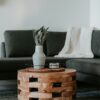Have you ever wondered how to breathe new life into your living room decor with something unique and functional? Well, I’ve been exploring the realm of bespoke furniture, and today I want to share some creative ways to make unique coffee tables that could transform your space. As someone who loves both DIY projects and innovative design ideas, putting together a one-of-a-kind coffee table is both a challenge and a delight.
The Charm of Custom Coffee Tables
Creating a custom coffee table is about more than just necessity; it’s about adding a personal touch to your space. A coffee table often serves as the centerpiece of your living room, so why not make it a conversation starter? It’s an opportunity to showcase artistry, craftsmanship, and your own unique style all at once.
Why Create Your Own Coffee Table?
Designing your own coffee table comes with numerous benefits. Beyond the personal satisfaction of creating something with your own hands, it can be more cost-effective than purchasing pre-made designer furniture. Moreover, it allows you to tailor the table precisely to your needs. Whether you’re looking to incorporate storage, need a specific shape or size, or want a table that perfectly matches your existing decor, making your own offers limitless possibilities.
Materials to Consider
Choosing the right materials is key to crafting a unique coffee table. From rustic wood to sleek metals, the material will define the table’s style and durability.
Wood: Traditional and Timeless
Wood is perhaps the most versatile material, offering a warm and classic look. Options like reclaimed wood can add character and history to your piece, while polished hardwoods offer a more refined appearance. Consider oak, pine, or cedar, as each wood type has its own color, grain pattern, and level of hardness.
Metal: Modern and Sleek
For a more industrial or contemporary vibe, metals like steel or aluminum can be fantastic choices. Metal can be incorporated through legs or as a frame around other materials. Its durability and sleek finish make it a popular choice among modern designs.
Glass: Elegant and Light
Glass can give your coffee table an air of sophistication. Whether you choose a full glass tabletop or glass accents, it can help small spaces feel more open due to its transparency. It’s perfect for creating an elegant and minimalist look.
Other Materials: Thinking Outside the Box
Don’t be afraid to experiment with unconventional materials. Concrete can bring a modern, edgy feel, while using tiles or mosaics can provide a vibrant, artistic touch. Leather, fabric, or even old suitcases can be upcycled to add unique flavor to your design.
Design Inspirations
Inspiration can come from anywhere, and when it comes to coffee tables, the possibilities are endless. Here are some concepts to spark your creativity.
Rustic Farmhouse
A rustic farmhouse coffee table emphasizes simplicity and tradition with a bit of a homely charm. Using reclaimed wood, you can create a design that’s both weathered and warm, providing a cozy centerpiece for your living room.
Mid-Century Modern
This design style is characterized by clean lines, minimal ornamentation, and a classic design. Consider using walnut wood with hairpin metal legs to achieve that iconic look. It blends seamlessly with both older and modern decor.
Industrial Chic
Industrial style integrates blackened steel and weathered wood, striking a balance between rugged and polished. An industrial chic coffee table often incorporates metallic elements and open framework, providing a robust and eye-catching design with a raw edge.
Eclectic and Artistic
For a bold statement, eclectic designs mix colors, textures, and materials. It’s about breaking the conventional rules and creating something that’s uniquely yours. Consider using an old door or window as a table surface or incorporate a colorful mosaic pattern.
Tools and Techniques
Building a coffee table requires the right tools and a bit of technical know-how. While the specific tools you need will depend on your chosen materials and design, there are a few basics that can help you get started.
Essential Tools
- Saw: A power saw (like a circular saw) is often necessary for cutting wood to size.
- Drill: For creating holes and driving screws.
- Sander: To smooth any rough surfaces for a professional finish.
- Hammer and Nails: Always useful for basic assembly tasks.
- Measuring Tape and Level: To ensure precision in your design.
Joinery Techniques
Joinery techniques can determine the strength and aesthetics of your coffee table:
- Butt Joints: Simplest and quickest, but may require brackets for additional strength.
- Dowel Joints: Offer a clean look with no visible fasteners.
- Mortise and Tenon: Classic woodworking joint known for its strength.
- Dovetail: More complex, but provides a beautiful and intricate connection.
Practical Considerations
While creativity is crucial in design, practicality ensures your coffee table serves its intended purpose effectively.
Size and Proportion
Your coffee table should fit comfortably within the space it will occupy. Ensure it’s proportional to surrounding furniture, not too overpowering or diminutive. Typically, the height of the coffee table should be about the same as the seating it accompanies, or slightly lower.
Functionality
Consider what purpose the coffee table will primarily serve. Is it simply for decorative purposes, or will you use it for storage or serving food and drinks? You might want to include shelves or drawers for storage, or even elements like built-in coasters or magazine racks.
Safety
Especially important if you have children, ensure the table doesn’t have sharp edges or unstable parts. Opt for rounded edges or soft corners, and securely fasten all joints to prevent any accidents.
Step-by-Step Guide to Crafting a Simple Coffee Table
While there are as many methods as there are makers, here’s a simplified guide to get you started on crafting your own basic coffee table.
Step 1: Plan Your Design
Sketch your coffee table design on paper, detailing dimensions and materials. Decide on a specific style that matches your decor, whether it’s modern, rustic, or something else entirely.
Step 2: Gather Materials
Purchase or upcycle the materials you’ve decided to use. Make sure to have a little extra for mistakes or adjustments.
Step 3: Cut and Prepare
Using your plans, measure and cut the materials to size. Sand down all pieces to remove rough edges and splinters.
Step 4: Assemble the Top
Begin by assembling the tabletop, securing wooden slats or boards together using your chosen joinery technique. Measure for accuracy to ensure a smooth, even surface.
Step 5: Attach Legs
Once the top is complete, attach legs or the base frame. Ensure everything is balanced and sturdy, adjusting as necessary.
Step 6: Add Finishing Touches
Treat the wood with a finish such as wax, varnish, or stain, depending on your preference. This not only improves the table’s appearance but also adds protection.
Step 7: Final Check
Finally, check your coffee table for stability and any rough spots that might need additional sanding. Adjust any loose fittings and admire your handiwork!
Sustainable Coffee Table Ideas
In today’s environmentally conscious world, sustainability is more important than ever. One way to embrace this is by using recycled or upcycled materials.
Pallet Wood Tables
Using pallet wood is an excellent eco-friendly option. It’s affordable, versatile, and can easily be customized. Ensure the pallets are heat-treated, rather than chemically treated, to prevent the release of harmful chemicals in your home.
Wine Crate Coffee Table
Repurpose old wine crates to form a charming and functional table with built-in storage spaces. With a bit of sanding and staining, wine crates can bring a touch of rustic elegance to your design.
Upcycled Door Coffee Table
Transform an old door into a large, statement coffee table. By adding legs and possibly a glass top, you retain the character of the door while creating a functional piece.
Conclusion
Crafting a unique coffee table not only brings a personal touch to your living space but also allows you to experiment with design and functionality. By selecting the right materials and techniques, and considering both creativity and practicality, you can create a masterpiece that tells your story. Take this opportunity to create something not just useful, but uniquely reflective of who you are. Maybe you’ll find that the process of designing and building your coffee table is just as fulfilling as the final product itself, and that’s something truly special.









